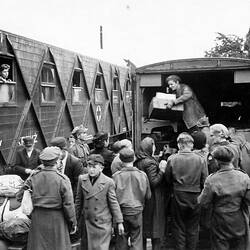Summary
Black and white photograph of a group of displaced persons who are queuing for supplies being unloaded from the back of an ambulance by Enid Whitton, one of the English camp workers. The people are Polish displaced persons being repatriated from camps in the Salzgitter region of Germany, from Heerte Railway Station in 1946. The train carriage has 'Krakow' painted on the side.
This is one of a collection of 24 photographs taken by English staff members of the Guide International Service (GIS) Team 107, part of the combined operation of the 112 Military Government, UNRRA [United Nations Relief and Rehabilitation Administration] and voluntary relief teams looking after the care and repatriation of persons displaced throughout Europe as a result of World War II. This team was working in camps in Germany from the east in the Salzgitter area from 1945 and in 1948-1949 across to the west in Bielefeld. The GIS included many Australian volunteers.
Description of Content
Black and white photograph with train carriage at left, rear view of ambulance with doors open, sacks of goods at bottom left and a group of people waiting for crates to be passed down from the ambulance.
Physical Description
Digital copy of a black and white photograph.
Significance
This collection of photographs provides a rare visual insight into the processes of transporting, relocating and repatriating displaced persons after World War II. Millions of people across Europe were displaced after the War, and countries such as England and Australia provided staff to assist with the massive coordination of processing the movement and migration of people. This group of photographs is of particular value as the photographer is known and has provided some background as to staff depicted in the images, the organisation they represented (the Guide International Service Team), the nature of the displaced persons (mostly Polish) and the locality (Salzgitter region in Germany). There is also recorded the names of some of the specific camps and the railway station where people were transported. There are also images of camp kitchens and offices providing further insights into camp management and staffing.
These photographs provided invaluable contextual imagery for the many stories of displacement represented in the Migration collection and the global documentation of the post World War II mass movement of people, including the 170,000 who migrated to Australia.
More Information
-
Collecting Areas
-
Acquisition Information
Copied from Mr Alan Tyldesley, Apr 2012
-
Place & Date Depicted
-
Photographer
-
Format
Digital file, TIFF, Black & White
-
Classification
-
Category
-
Discipline
-
Type of item
-
References
Phyllis Stewart Brown 'All Things Uncertain: the Story of the G.I.S.' [Girl Guides Association, 1966] Alan Tyldesley 'Germany 1945/1946. The Care and Repatriation of Displaced Persons from Camps in the Salzgitter Area' [unpublished manuscript compilation, Feb 2011]
-
Keywords
Displaced Persons, Displaced Persons Camps, World War II, 1939-1945, Military History, Refugees

